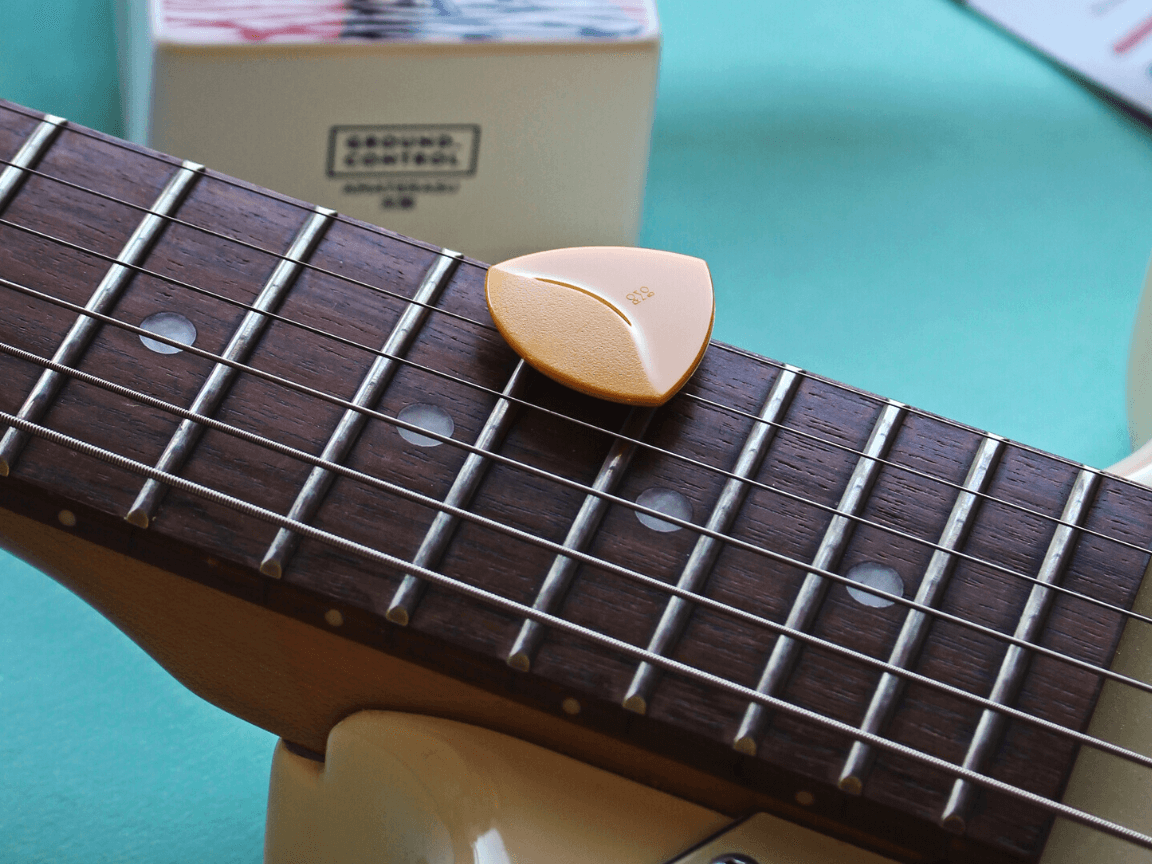When you start playing the guitar, one of the most important things to do is make sure that your instrument is in tune.
This can be done manually using a tuning fork or by ear, or you can use a guitar tuner to make the process a little bit easier.
But is one of these methods better than the others? And which is the best option for you?
In this blog post, we’ll break down all of the options available and go into more depth about the pros and cons of each one.
Let’s get started!
Table of Contents
- Should you buy a guitar tuner or just use an app?
- What is a guitar tuner and what does it do?
- How does a guitar tuner app work?
- Types of guitar tuners available
- How to tune your guitar using a tuner?
- Pros and cons of each tuning method
- Which are the best tuners available for you?
- Do you need a tuner at all?
Should you buy a guitar tuner or just use an app?
The quick answer is that it depends on your needs and preferences. If you are a beginner or only play guitar occasionally, an app may be sufficient. However, if you are a more serious player, or play in a band, you will probably need a tuner that is more accurate and reliable than an app.
Apps can be convenient because they are usually free, and you can keep them on your phone or tablet.
Many guitar tuner apps also have other features, such as a metronome, which can be useful for practicing.
There are many different types of guitar tuners available on the market, so it is important to choose one that is right for you.
What is a guitar tuner and what does it do?
A guitar tuner is a device that helps you tune your guitar by detecting the pitch of the strings and displaying it on a screen.
Most guitar tuners also have a built-in microphone so they can be used without an external one.
Guitar tuners work by detecting the pitch of the sound waves produced by the vibrating strings of the guitar.
The pitch is then displayed on a screen, which tells the player whether the string is too high or low in pitch.
For example, if the guitar tuner shows that the note E is too low, the player would need to tighten the string to raise the pitch.
How does a guitar tuner app work?
Guitar tuners apps work in a similar way to regular guitar tuners, but instead of using a physical device, they use the microphone on your phone or tablet.
The app detects the pitch of the sound waves produced by the vibrating strings of the guitar and displays it on a screen.
Just like regular guitar tuners, this lets the player know whether the string is too high or low in pitch.
Let’s take a look at this YouTube video by BoogieBoy36 in which he gives us a tutorial on how to use GuitarTuna:
As you can see, just like we mentioned before, the app is very straightforward.
It automatically detects which string you’re plucking and it works around to help you tune it; on the other hand, you can use disable the auto function and do that on your own.
Once a string is tuned, you’ll know it as soon as you notice the checkmark in a green circle that appears on top of the guitar in the app.
Types of guitar tuners available
Chromatic tuners
Chromatic tuners are the most common type of tuner. They can be used with any type of instrument and detect a wide range of pitches.
Most chromatic tuners have a microphone built-in, but some also have an input for an external microphone.
The chromatic scale is a set of twelve pitches used in tonal music, with notes separated by the interval of a semitone.
When it comes to tuners, the term “chromatic” means that you will be able to tune to every note in the chromatic scale.
These notes are: A, A#/Bb, B, C, C#/Db, D, D#/Eb, E, F, F#/Gb, G, G#/Ab
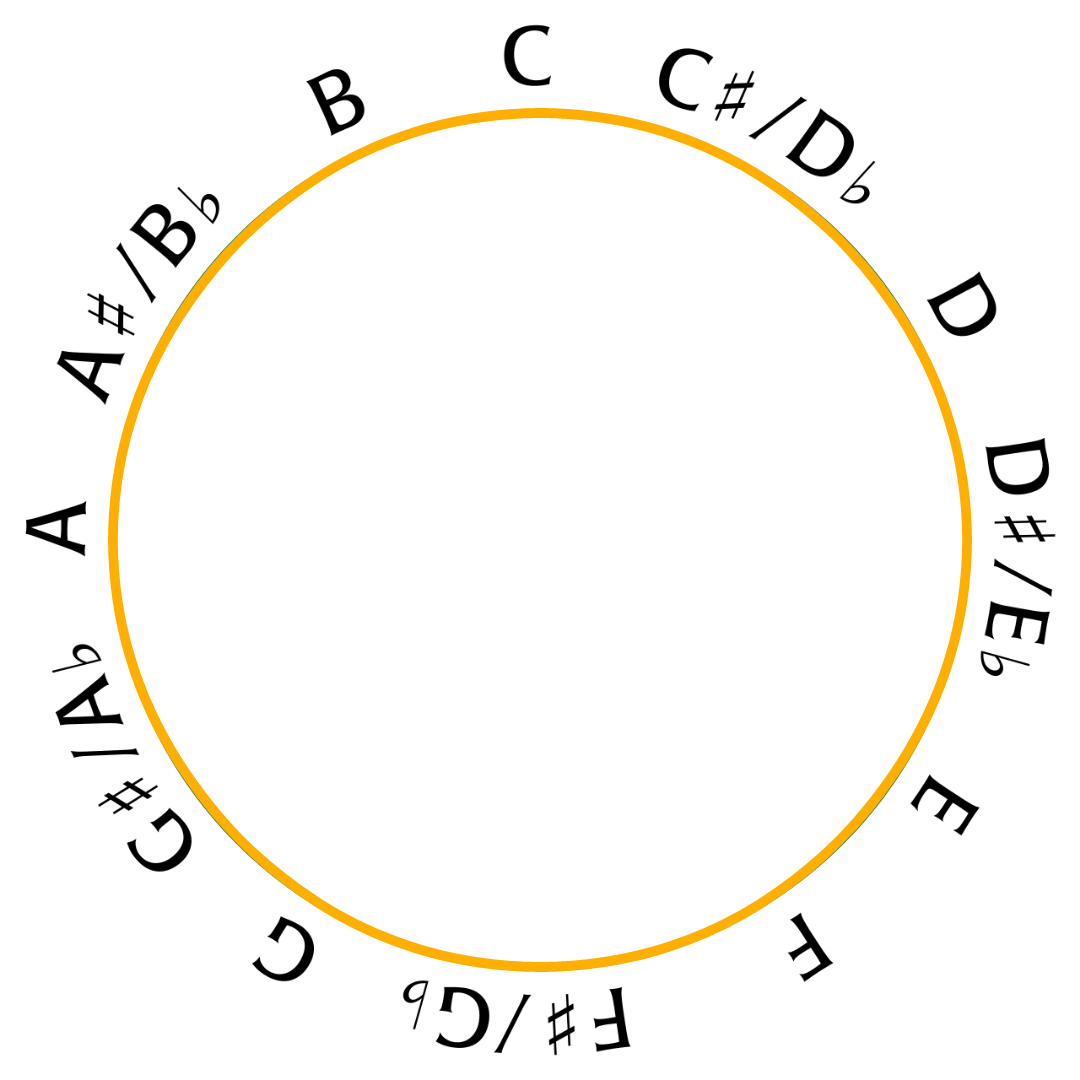
Any chromatic tuner lets you tune your instruments in alternative tunings, that is drop D, open D, G E, and flat tuning.
These types of tuners will detect any note that you play on your guitar and will display how flat or sharp you are relative to the nearest semitone.
Just that you can gain some perspective, a non-chromatic tuner can only recognize the notes of a guitar in standard tuning, meaning you can only tune EADGBE.
Polyphonic tuners
Polyphonic tuners are a newer type of tuner that can detect multiple pitches at the same time.
This is useful for guitars because it means you can tune all of the strings without having to pluck them one at a time.
The main advantage of polyphonic tuners is that they are much faster than chromatic tuners.
At the same time, they are also more accurate because they can take into account the relationships between the different strings.
However, polyphonic tuners are more expensive than chromatic tuners, so they may not be the best option for everyone
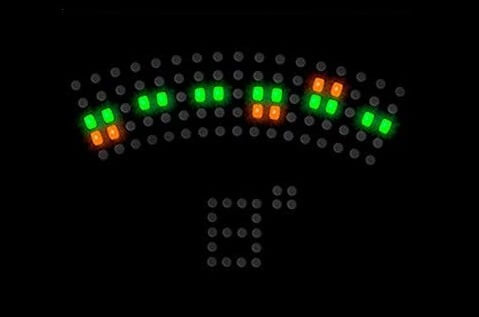
In the example above, we can see that the 6th, 3rd, and 2nd strings are out of tune.
For a live performer, or anyone playing in front of an audience, you can obviously see the benefits of something like this, since just a minute of silence can feel like forever when a solo artist is tuning his instrument.
Microphone
A microphone by itself won’t be able to tune your instrument, but for instance, a web guitar tuner expects you to have one.
These mics can be either built-in or external, but either way, they’re needed in some situations.
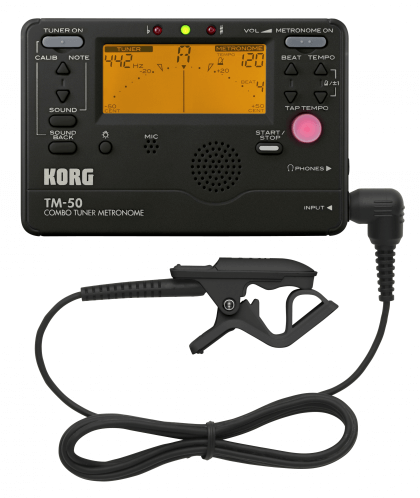
In the image above, you can see that an external mic is needed for this specific tuner, this one is the Korg TM50BK Combo Tuner Metronome.
If your guitar tuner doesn’t use vibration sensors to detect the pitch of a string, it most likely uses a microphone.
These types of tuners are less accurate since they tend to catch background noises as well, but they are the least expensive options out there and will definitely get the job done.
Strobe
Tuners that use strobe displays are the most accurate ones, but they are also the most expensive.
The word “strobe” is a short term for “stroboscopic.”
A strobe tuner is able to show you the difference between a reference frequency and the musical note being played, and this can happen even with the slightest difference between the two.
The way that these tuners work is essentially by using a mechanical spinning disk with a strobe pattern that’s backlit by lights that flash at a rate similar to the frequency of the signal being analyzed.
Once you’ve correctly tuned a certain string, the speed of the disk will match the rate of the flashing lights, which will make it seem as if the disk stopped moving.
Although in general, they will be more costly, for some people, this exactness is quite often what makes them worth paying for.
These are the go-to for guitar technicians, manufacturers, and professional players.
Mobile app
Mobile app tuners have recently become one of the most easy-to-use and convenient types of guitar tuners.
With the increasing development of technology that we have, smartphone microphones continue to get better and tuner apps have inevitably also gotten more reliable.
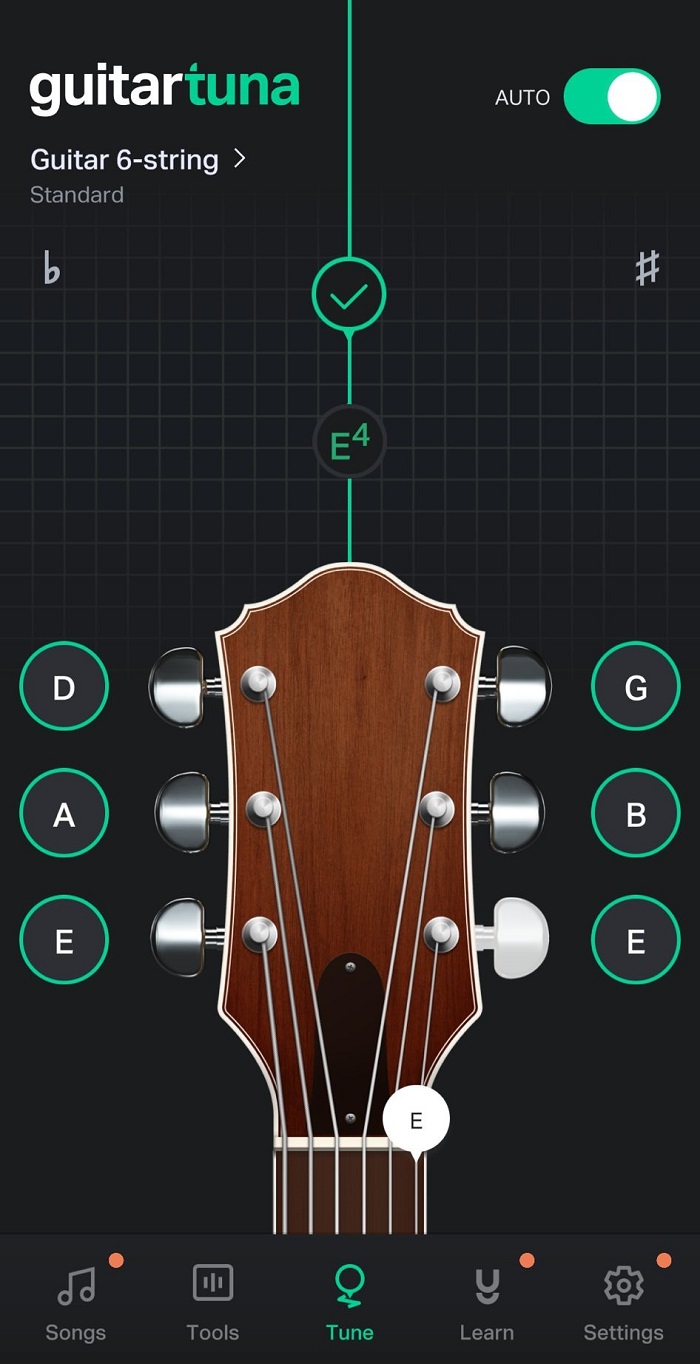
As long as there is little ambient noise around, most tuner apps are usually accurate within +/- 1-3 cents (remember that the human ear can only detect pitch changes of about 5 cents).
To put it another way, if you tune a guitar with the most accurate tuner in the world and tune a second guitar with a mobile app, any normal person won’t be able to tell the difference between the two.
And yes, in theory, the discrepancy will be there, but still, for the average person, the apps will do the trick.
How to tune your guitar using a tuner?
The first step is to find a note that you can use as a starting point.
This note can be from another instrument, your own voice, or even a tuning fork.
Once you have found a starting note, pluck the string that you want to tune and turn the corresponding tuning peg until the pitch of the note matches the pitch of the string.
Repeat this process for each string on your guitar until all of the strings are in tune.
If you’re using a chromatic tuner, you will need to pluck each string one at a time and adjust the tuning peg until the display shows that the string is in tune.
Pros and cons of each tuning method
There are a few different types of tuners that guitar players use.
Each type of tuner has its own set of pros and cons.
In this section, we will discuss the pros and cons of each type of tuner and will also provide a few recommendations for each type of tuner.
Clip-on tuners pros and cons
Clip-on tuners are a type of tuner that attaches to the headstock of your guitar.
They are one of the most popular types of tuners because they are very easy to use and they are also very accurate and inexpensive.
The main downside to clip-on tuners is that they can be a bit bulky and can get in the way while you’re playing.
Another downside is that they can sometimes pick up background noise, which can cause the tuner to be inaccurate.
Pedal tuners pros and cons
Pedal tuners are very popular among guitarists because they offer more accurate tuning than a microphone or mobile app tuners.
They work by sensing the vibrations of the strings, so they are less likely to be affected by background noise.
However, pedal tuners can be expensive, and they can also be bulky and inconvenient to carry around.
App tuners pros and cons
Some pros of using a mobile app tuner are that they are generally accurate, easy to use, and convenient.
They can also be used in a variety of settings, such as when you’re on the go or in a noisy environment.
Additionally, many apps are free to download.
However, some cons of using an app tuner are that they can be inaccurate in loud environments.
They may also not be as accurate as other types of tuners, and they may not be as readily available as other types of tuners.
Which are the best tuners available for you?
There are a lot of different guitar tuners on the market these days.
Some are better than others, so, which one is the best for you?
In the following section, we will take a look at some of the best tuners on the market and help you decide which one is right for you.
TC Electronic PolyTune 3 Guitar Tuner Pedal
(link to Amazon.com)
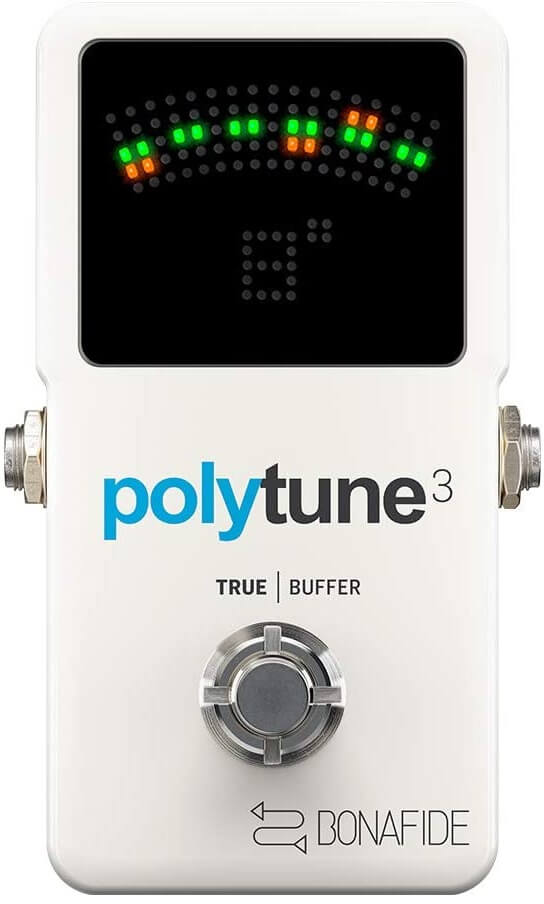
TC Electronic’s PolyTune 3 guitar tuner pedal is a polyphonic tuner and has an inherent BonaFide buffer, which many other pedal tuners don’t have.
This is a very helpful feature as it preserves your tone through long cable runs and convoluted pedalboards.
To be a polyphonic tuner means that you will be able to tune all your strings at once; in other words, a single strum of all your strings will allow the pedal to quickly display which ones are out of tune and which ones aren’t.
With this pedal, you’ll have multiple tuning modes at your disposal, including polyphonic, chromatic, strobe, and a variety of altered tunings.
The switches happen almost automatically since the change between polyphonic and monophonic tuning modes happens based on how many strings you play.
On the other hand, its buffer keeps your tone transparent and crisp with a 1MΩ input, a 100Ω output, and an extremely high signal-to-noise ratio, to be exact, more than 112 dB.
PolyTune 3 lets you switch between true bypass and buffer modes, this last one gives you an ‘always on’ option that keeps the tuner in full operation even while your signal is not muted.
Fender FT-2 Professional Clip-on Tuner
(link to Amazon.com)
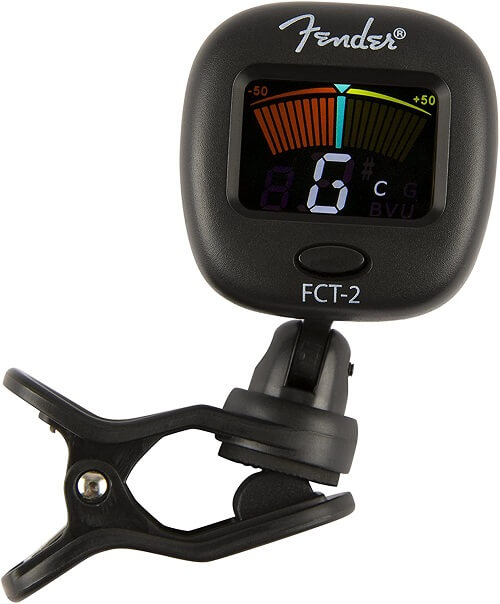
This is one of Fender’s famous clip-on guitar tuner models that are comfortable and very unobtrusive.
If you’re looking for a simple tuner that will flawlessly work, even in distortive environment conditions, then the FT-2 is a great option to consider as it possesses a great built-in vibration sensor.
The color LCD (liquid crystal display) shows a very easy-to-read tuning needle that will indicate and display how near to pitch each note is and move to the center mark once the note is in tune.
Even though many people don’t know, these tuners can also be used for other instruments as well, for instance, bass guitars, ukuleles, and violins.
The FCT-2’s double pivot design allows you to mount the tuner on either side of your instrument’s headstock, which can be very useful if you want to “hide” the tuner from an audience or simply keep the aesthetic very simple.
When it comes to color, this model is only available in black, but other versions come in Surf Green, Fiesta Red, and Daphne Blue.
To get the full list, check out our post on the best guitar tuners that are actually worth having!
Do you need a tuner at all?
I recommend everybody to have at the very least a tuner app available at all times.
Ideally, you should tune your instruments every time before you start playing them.
There are a number of ways to tune your guitar, and you don’t necessarily need a tuner to do so.
However, if you want accurate tuning, a tuner is the best way to go, plus playing any guitar that is out of tune has to be the worse feeling ever.
If you’re a beginner who’s starting out, you’ll want to make sure that your guitar is tuned at all times.
Any subtle mistake that you make and every time that you play, you want to make that if it doesn’t sound good, is because of you and not your guitar.

More than 10 years of experience playing and writing about guitars! When not writing, I can be found strumming away some Johnny Cash tunes. Favorite all time guitar is the Gibson Les Paul. #TeamGibson


